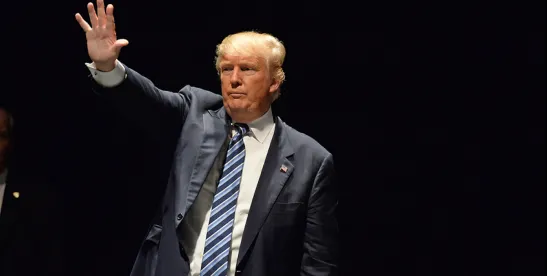As companies and others in the regulated community continue to evaluate their strategies in light of the Trump administration’s rollout of its deregulatory agenda, we highlight a notable executive order (EO), Executive Order 14219, issued on February 19, 2025, entitled “Ensuring Lawful Governance and Implementing the President’s ‘Department of Government Efficiency’ Deregulatory Initiative," that could have wide-ranging implications for numerous environmental (and other) regulations, as well as current and future enforcement actions and criminal prosecutions.
Key Takeaways and Potential Actions/Next Steps for the Regulated Community:
- The EO directs agencies to review existing regulations to identify certain categories of regulations for rescission, such as those that raise constitutional questions. This instruction builds on previous EOs directing agency review of regulations.
- The EO also addresses enforcement actions, directing agencies to “de-prioritize” future actions to enforce regulations that “are based on anything other than the best reading of the statute” or that exceed Federal authority. This suggests that the Administration will not continue pursuing certain categories of enforcement actions based on novel legal theories.
- As to pending enforcement actions, the EO directs agencies to determine whether “ongoing enforcement” is “compliant with law and Administration policy.” The EO states that agencies shall “direct the termination of all such enforcement proceedings that do not comply with the Constitution, laws, or Administration policy.” This instruction is unusual; past Administrations have changed enforcement policies but have rarely terminated pending enforcement actions.
- If they have not already done so, companies should audit their regulatory priorities and develop strategies based on likely actions of the Trump Administration as announced in early executive orders and other actions.
- Companies should also evaluate each pending agency enforcement action and criminal investigation and potentially refine their strategy for the ongoing and future negotiation/resolution of that action. Companies should also be mindful that any perceived reduction in federal enforcement may come with expanded citizen suit, state enforcement, or plaintiff litigation activity, and good corporate citizenship and compliance with fundamental environmental laws is always a sound business practice and mitigates both regulatory and enforcement risk.
We discuss the potentially significant enforcement implications in more detail below.
Review of Regulations Under the Executive Order
President Trump has already issued several executive orders requiring agencies to review and rescind past regulations, including a regulatory freeze executive order, an order rescinding past executive orders and directing a review of past agency actions implementing those orders, and an order directing agencies to review and rescind regulations that burden the use of domestic energy resources. A separate order directs agencies to rescind ten regulations for each new regulation they adopt and reduce the costs of regulation to the public.
The new EO builds on these past orders by setting out a list of criteria for agencies to apply when reviewing their regulations. Under sections 2(a) and 2(c), within 60 days, agencies must prepare a list of regulations meeting these criteria, in consultation with the agencies’ Department of Government Efficiency (DOGE) Team Leads, and provide the list to the Administrator of OMB’s regulatory office, the Office of Information and Regulatory Affairs (OIRA). Under section 2(d), the Administrator of OIRA will then “consult with agency heads to develop a [new/updated] Unified Regulatory Agenda that seeks to modify or rescind those regulations.”
The classes of regulations to be identified under the EO are:
“(i) unconstitutional regulations and regulations that raise serious constitutional difficulties, such as exceeding the scope of the power vested in the Federal Government by the Constitution;
(ii) regulations that are based on unlawful delegations of legislative power;
(iii) regulations that are based on anything other than the best reading of the underlying statutory authority or prohibition;
(iv) regulations that implicate matters of social, political, or economic significance that are not authorized by clear statutory authority;
(v) regulations that impose significant costs upon private parties that are not outweighed by public benefits;
(vi) regulations that harm the national interest by significantly and unjustifiably impeding technological innovation, infrastructure development, disaster response, inflation reduction, research and development, economic development, energy production, land use, and foreign policy objectives; and
(vii) regulations that impose undue burdens on small business and impede private enterprise and entrepreneurship.”
Some of these categories overlap with considerations identified in past executive orders – considerations of cost are captured by class (v) and by a previous executive order, and energy and infrastructure are addressed in class (vi) in President’s Trump’s energy EO. Other categories (classes (i) through (iv)) echo language from recent Supreme Court decisions concerning the “major questions doctrine” and anticipate likely future challenges under the non-delegation doctrine, suggesting that the administration intends the EO to work hand-in-hand with its legal strategy for challenging the administrative state.
The broad categories of regulations to be reviewed touch upon concerns that have been raised with respect to virtually every significant environmental rulemaking, opening up the scope of potential regulations subject to the order to nearly all rules. The scope of this review will extend to regulations adopted well before the Biden administration, and is more far-reaching than the previous Trump executive orders on regulatory review and rescission. For example, stakeholders have argued that EPA’s Waters of the United States rule exceeds EPA’s authority under the Commerce Clause (class (i) on the list above), that EPA’s power plant greenhouse gas standards violate the “major questions” doctrine (class (iv)), and that the recent Hazardous Organics NESHAP amendments were an unlawful second risk review not contemplated by the Clean Air Act (class (iii)). The EO provides in section 4 that this list of criteria shall also be considered in evaluating potential new regulations.
Enforcement Implications of the Executive Order
The new EO’s enforcement provisions, which appear in Section 3 of the order, are equally significant and respond to long-standing industry objections about enforcement overreach by EPA and other federal agencies. Industry has expressed concerns about a rulemaking-by-enforcement paradigm that forces companies to acquiesce to massive and costly extra-regulatory requirements that circumvent the Administrative Procedure Act. Agencies would otherwise face substantial difficulty adopting such requirements under the various environmental rulemaking cost-benefit analyses required by statute. See, e.g., B&D News Alert on Biden EPA’s Benzene Enforcement Initiative.
Narrowly Tailored Scope of Enforcement Actions
Section 3(a) of the EO directs agencies to “preserve their limited enforcement resources” and to “de-prioritize” future actions to enforce regulations that “are based on anything other than the best reading of the statute” or that “go beyond the powers vested in the Federal Government by the Constitution.” The first element of this instruction could affect enforcement actions under a number of regulatory schemes that stakeholders have argued exceed the agency’s authority, on topics ranging from climate change to air emissions to worker safety. The second element could encompass situations in which a regulation arguably exceeds the scope of the underlying Constitutional grant of authority; in environmental cases, this is typically the Commerce Clause. Broad agency assertions of agency enforcement authority and novel agency interpretations of law can also implicate the Due Process Clause. The second element potentially also reaches situations in which federalism considerations suggest that a State should more properly exercise any enforcement authority.
Pending Cases
Section 3(b) of the EO directs agencies to review pending enforcement actions to ensure that they are “compliant with law and Administration policy” and instructs agency heads, “on a case-by-case basis and as appropriate and consistent with applicable law,” to “direct the termination of all such enforcement proceedings that do not comply with the Constitution, laws, or Administration policy.” This is an unusual provision; past Administrations have changed enforcement policies but have rarely terminated pending enforcement actions. The criteria for review of pending enforcement cases are broad, and allow dismissal of a case for inconsistency with “Administration policy.” By contrast, the rest of the executive order provides more specific criteria to govern agency review.
Agencies presumably have the authority to suspend or withdraw administrative enforcement actions without any special process and can likewise dismiss civil cases voluntarily if no answer has been filed. For civil cases in which an answer has been filed, termination of a pending enforcement action would typically require either the agreement of defendant, under Federal Rule of Civil Procedure 41(a)(1)(A)(ii), or a court order, under Rule 41(a)(2). For criminal cases, court approval is again likely to be required.








 />i
/>i

